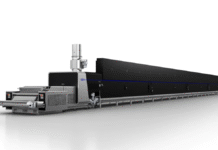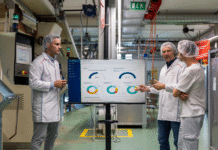
At its OneBarrier webinar on 8 June 2021, Dennis Hughill, the regional sales director of Bobst Manchester, introduced senior research scientist Dr Carolin Struller from the company’s R&D at Manchester. Struller began by explaining that the CEFLEX plan has three pillars for flexible packaging sustainability that need to be achieved by 2025. “When looking at global market trends for sustainable, flexible packaging, the trends can be grouped into three pillars of sustainability – mono-material polyolefins; compostable, biodegradable, bio-based films; and, paper or fiber-based solutions. Today, the webinar focuses on a new approach using polyolefin (PP/PE) based solutions based on a single polymer family to improve recyclability.”
Struller said, “2025 is round the corner, and collaboration has come out of the necessity of meeting the CEFLEX goals. Brand owners are also initiating discussions and developments with all the suppliers in the value chain. We are illustrating just one solution which moves us from polyester to polyolefins and from polar to non-polar structures. Additionally, we have conducted various tests on our trial materials since decisions must be based on facts.”
She added that the OneBarrier approach took its definition of a mono-material from the CEFLEX guidelines. These state that the packaging structure needs to be compatible with the current mechanical recycling process and contain at least 90% by weight of PE or PP – other components such as adhesives, coatings, and inks can each have a maximum of 5% by weight.
The presentations reiterated that the solutions require deep collaborations between suppliers of technology, equipment, and raw materials. The webinar proposed a concept and a practical solution for a mono-material full-PE transparent structure as an alternative to metalized polyester film – a further development of earlier mono-material MDO PE high barrier solutions. The collaboration with Dow, Zermatt, and Sun Chemical, yielded an EVOH-free solution incorporating the AlOx GEN II process and eliminating the need for a topcoat.
The OneBarrier process
Struller outlined the oneBarrier process, saying the first stage is the resin production by Dow – a special resin designed to maximize thermal resistance and coating and deposition reception to achieve the barrier requirements. Next, the film was produced by Bobst customer Zermatt who used a PE blown film line with an MDO module in Spain to make 12 rolls of MDO PE film.
The MDO PE film reels were sent to Italy, where a primer layer was applied using a Vision D 850 at Bobst Italia’s Competence Centre. Then an AlOx deposition using the Gen II process was applied on an Expert K5 vacuum metallizer in Bobst’s Competence Centre in Manchester. The next step was to apply Sun Chemical’s Paslim solvent-free barrier adhesive on the Nova SX 550. The overall process eliminates the need for a topcoat. The test project was reverse printed on a CI flexo press.

Roman Cazenave, the group marketing director for EMEA of Dow Packaging and Specialty Plastics, spoke of the need to produce flexible packaging that retains value even for the recyclers. The specially developed PE resin for this alternative film development must have the stiffness and optical properties that the market expects. He added that the packaging using the new structures should work well on filling and sealing machines and thus enable the management of friction (COF) and have highly efficient heat sealing properties.
Bernd Bayer, head of R&D of Hosokawa Alpine Germany, explained how the MDO unit stretches the blown film as much as ten times but that the stretching process creates a neck and thicker edges that require trimming. The company already has 50 MDO units installed in the market. Recently it introduced the MDO 04 V+ system that heats, stretches, anneals, and cools the film, followed by its TRIO edge trimmer, which is key to economically providing a thin and flat film structure. In addition, the trimmed material is reused on the same blown film line.
Richard Sandbrook deputy engineering director Bobst Manchester explained some of the Bobst K5 Expert GenII vacuum metalizing technology features, specifically designed for thin PE materials. The Expert K5 uses a thinner metal layer to create the needed barrier with uniformity and higher transparency. It also has a plasma feature for introducing polarity on mono-material PE structures.

Struller summed up by saying that while earlier mono-material solutions using MDO PE films used EVOH, the idea was to eliminate EVOH to reduce the cost and yet meet the oxygen and moisture barrier compliances and market requirements for transparent flexible films. This was ultimately achieved using Dow’s special resin and extruding it on a Hosokawa Alpine blown film line with an MDO unit and after the appropriate primer coating using the AlOx Gen II process for an extremely thin metalized layer. The result was a topcoat-free structure that meets the strictest compliances that ask for less than 2% of contaminants and is significantly cheaper than the earlier PE MDO film using EVOH.
Bobst says the OneBarrier solution is available immediately, and it’s ready to help with its implementation and execution. However, this will require a considerable commitment to sustainability as well as expertise and testing capability. As shown, it will also need special resins, adhesives, coatings, and hardware from the respective suppliers. These are, namely, Dow and Sun Chemical. The main hardware components are Hosokawa Alpine’s blown film line with its MDO 04 V+ unit, Bobst’s K5 Expert vacuum metallizer, and its coater laminators.
IndiFoodBev — authentic, impactful and influential
An English-language food and beverage processing and packaging industry B2B platform in print and web, IndiFoodBev is in its third year of publication. It is said that the Indian food and beverage industries represent approximately US$ 900 billion in revenues which implies more than 20% of the country’s GDP. Eliminating the wastage on the farmside can help to deliver more protein to a higher number of the population apart from generating sizable exports. The savings in soil, seeds, water, fertilizer, energy and ultimately food and nutrition could be the most immense contribution that country is poised to make to the moderation of climate change.
To improve your marketing and grow sales to the food and beverage processing and packaging industry, talk to us. Our research and consulting company IppStar [www.ippstar.org] can assess your potential and addressable markets in light of the competition. We can discuss marketing, communication, and sales strategies for market entry and growth.
Suppliers and service providers with a strategy and budget for targeted marketing can discuss using our hybrid print, web, video, and social media channels to create brand recognition linked to market relevance. Our technical writers are ready to meet you and your customers for content.
The second largest producer of fruit and vegetables in the world is continuously expanding processing capacities and delivery systems with appropriate innovative technologies. We cover product and consumer trends, nutrition, processing, research, equipment and packaging from farm to thali. Get our 2025 media kit and recalibrate your role in this dynamic market. Enhance your visibility and relevance to existing markets and turn potential customers into conversations. Ask for a sample copy of our bi-monthly in print or our weekly IndiFoodBev eZine each Wednesday.
For editorial info@ippgroup.in — for advertisement ads1@ippgroup.in and for subscriptions subscription@ippgroup.in
Naresh Khanna – 10 February 2025
Subscribe Now










